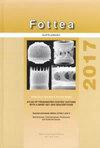Annamia dubia sp.nov.并报道一个新科,Geminocystaceae家族。nov.(蓝藻)
IF 1.4
3区 生物学
Q3 PLANT SCIENCES
引用次数: 5
摘要
我们的环境DNA分析在2012年6月至2015年5月期间,每年夏季都会从日本卡苏米高拉湖鉴定出类似Annamia的操作分类单元(OTU)。用细胞分选机建立了一种来自Kasumigaura湖的菌株,该菌株与Annamia样OTU一致(NIES-4383)。根据形态和16S rRNA序列的差异,描述了一个新的分类单元:Annamia dubia Tuji,Yamaguchi et Niiyama sp.nov.a.dubia产生一种微囊藻毒素,该毒素也由a.toxix产生。我们的16S rRNA系统发育分析表明,Annamia属与Geminocystis属、Geminobacterium属和“Cyanobacteria”属组成一个单系分支尽管该分支与蓝细菌科Komarek等人一致。(2014),但基于无效的蓝细菌属和模式种斯坦蓝细菌,该科是无效的。我们提出了另一个名称Geminocystacee Tuji,Yamaguchi et Niiyama fam。nov.基于Geminocystis属。本文章由计算机程序翻译,如有差异,请以英文原文为准。
Annamia dubia sp. nov. with a description of a new family, Geminocystaceae fam. nov. (Cyanobacteria)
Our environmental DNA analysis identified Annamia-like operational taxonomic units (OTUs) from Lake Kasumigaura, Japan every summer season during the period from June 2012-May 2015. A strain from Lake Kasumigaura that agreed with an Annamia-like OTU (NIES-4383) was established with a cell-sorting machine. Based on the differences in morphology and 16S rRNA sequences, a new taxon is described: Annamia dubia Tuji, Yamaguchi et Niiyama sp. nov. A. dubia produces a microcystins that is also produced by A. toxica. Our 16S rRNA phylogenetical analysis reveals that the genus Annamia makes a monophyletic clade with the genera Geminocystis, Geminobacterium, and 'Cyanobacterium.' Although this clade agrees with Cyanobacteriaceae Komarek et al. (2014), this family is invalid based on the invalid genus Cyanobacterium and the type species Cyanobacterium stanieri. We propose the alternative name Geminocystaceae Tuji, Yamaguchi et Niiyama fam. nov. based on the genus Geminocystis.
求助全文
通过发布文献求助,成功后即可免费获取论文全文。
去求助
来源期刊

Fottea
生物-植物科学
CiteScore
4.00
自引率
9.10%
发文量
20
审稿时长
>12 weeks
期刊介绍:
Fottea is a journal of Czech Phycological Society (formerly bulletin Czech Phycology). Fottea publishes papers on all aspects of the ecology, physiology, biochemistry, cell biology, molecular biology, systematics and uses of algae (including cyanobacteria)
 求助内容:
求助内容: 应助结果提醒方式:
应助结果提醒方式:


